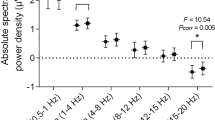Abstract
All-night EEG recordings from 12 male apnea patients and 12 age-matched healthy control subjects were studied in the present work. The spectral mean frequency was used to provide computational sleep depth curves from two frontopolar and two central EEG channels. Our previously presented computational parameters quantifying the properties of the sleep depth curves were improved. The resulting light sleep percentage (LS%) values were higher in apnea patients than in control subjects in the right central brain position (P = 0.028), in concordance to our previous work. Moreover, apnea patients showed higher LS% values in the right frontopolar position (P = 0.008). Also, apnea patients showed a smaller anteroposterior sleep depth difference than control subjects on the right hemisphere (P = 0.002). These are interesting new findings, achieved by the present methodology. Thus, the developed computational parameters were able to quantify, at least to some degree, the disruption of sleep process caused by the recurrent apneic events.



Similar content being viewed by others
References
Amzica F, Steriade M (1998) Electrophysiological correlates of sleep delta waves. Electroencephalogr Clin Neurophysiol 107:69–83. doi:10.1016/S0013-4694(98)00051-0
Anderson C, Horne JA (2003) Prefrontal cortex: links between low frequency delta in EEG in sleep and neuropsychological performance in healthy, older people. Psychophysiology 40(3):349–357. doi:10.1111/1469-8986.00038
De Gennaro L, Ferrara M, Curcio G, Cristiani R (2001) Antero-posterior EEG changes during the wakefulness-sleep transition. Clin Neurophysiol 112(10):1901–1911. doi:10.1016/S1388-2457(01)00649-6
Heinzer R, Gaudreau H, Decary A, Sforza E (2001) Slow-wave activity in sleep apnea patients before and after continuous positive airway pressure treatment. Chest 119:1807–1813. doi:10.1378/chest.119.6.1807
Himanen S-L, Joutsen A, Virkkala J (2004) Visual assessment of selected high amplitude frontopolar slow waves of sleep: differences between healthy subjects and apnea patients. Clin EEG Neurosci 35:125–131
Huupponen E, Värri A, Hasan J, Himanen S-L, Lehtokangas M, Saarinen J (2000) Optimization of sigma amplitude threshold in sleep spindle detection. J Sleep Res 9(4):327–334. doi:10.1046/j.1365-2869.2000.00220.x
Huupponen E, Himanen S-L, Hasan J, Värri A (2003) Automatic analysis of electroencephalogram sleep spindle frequency throughout the night. Med Biol Eng Comput 41(6):727–732. doi:10.1007/BF02349981
Huupponen E, Himanen S-L, Hasan J, Värri A (2004) Automatic quantification of light sleep shows differences between apnea patients and healthy subjects. Int J Psychophysiol 51(3):223–230. doi:10.1016/j.ijpsycho.2003.09.007
Huupponen E, Saastamoinen A, Joutsen A, Virkkala J, Alametsä J, Hasan J et al (2005) Anteroposterior difference in EEG sleep depth measure is reduced in apnea patients. J Med Syst 29(5):527–538. doi:10.1007/s10916-005-6109-1
ISBN-international classification of sleep disorders (1997) Diagnostic and coding manual. American Sleep Disorders Association, Rochester, pp 28–38
Isono S, Remmers JE (1994) Anatomy and physiology of upper airway obstruction. In: Kryger MH, Roth T, Dement WC (eds) Principles and practice of sleep medicine. WB Saunders, Philadelphia, pp 642–656
Jones K, Harrison Y (2001) Frontal lobe function, sleep loss and fragmented sleep. Sleep Med Rev 5:463–475. doi:10.1053/smrv.2001.0203
Kay SM, Marple SM (1981) Spectrum analysis: a modern perspective. Proc IEEE 69:1380–1419. doi:10.1109/PROC.1981.12184
Lapinlampi A-M, Himanen S-L (2004) Sleep staging with frontopolar EEG derivation. Sleep Hypn 6(2):58–64
Penzel T, Stephan K, Kubicki S, Herrmann WM (1991) Integrated sleep analysis, with emphasis on automatic methods. In: Degen R, Rodin EA (eds) Epilepsy, sleep and sleep deprivation 2nd edn Elsevier, London, pp 177–200
Rechtschaffen A, Kales A (1968) A manual of standardized terminology, techniques and scoring system for sleep stages of human subjects. Public Health Service, U.S. Government Printing Office, Washington, U.S
Rezek IA, Roberts SJ (1998) Stochastic complexity measures for physiological signal processing. IEEE Trans Biomed Eng 45(9):1186–1191. doi:10.1109/10.709563
Saastamoinen A, Oja H, Huupponen E, Värri A, Hasan J, Himanen S-L (2006) Topographic differences in mean computational sleep depth between healthy controls and obstructive sleep apnoea patients. J Neurosci Methods 157:178–184. doi:10.1016/j.jneumeth.2006.04.007
Saastamoinen A, Huupponen E, Värri A, Hasan J, Himanen S-L (2007) Systematic performance evaluation of a continuous-scale sleep depth measure. Med Eng Phys 29(10):1119–1131. doi:10.1016/j.medengphy.2006.11.004
Terzano MG, Parrino L, Boselli M, Spaggiari MC, Di Giovanni G (1996) Polysomnographic analysis of arousal responses in obstructive sleep apnea syndrome by means of the cyclic alternating pattern. J Clin Neurophysiol 13(2):145–155. doi:10.1097/00004691-199603000-00005
Acknowledgments
This work was financially supported by the Research fund of the Tampere University Hospital, the Tampere Tuberculosis foundation, the Finnish Cultural foundation, the Emil Aaltonen foundation, as well as the Jenny and Antti Wihuri foundation.
Author information
Authors and Affiliations
Corresponding author
Rights and permissions
About this article
Cite this article
Huupponen, E., Saunamäki, T., Saastamoinen, A. et al. Improved computational fronto-central sleep depth parameters show differences between apnea patients and control subjects. Med Biol Eng Comput 47, 3–10 (2009). https://doi.org/10.1007/s11517-008-0374-3
Received:
Accepted:
Published:
Issue Date:
DOI: https://doi.org/10.1007/s11517-008-0374-3




